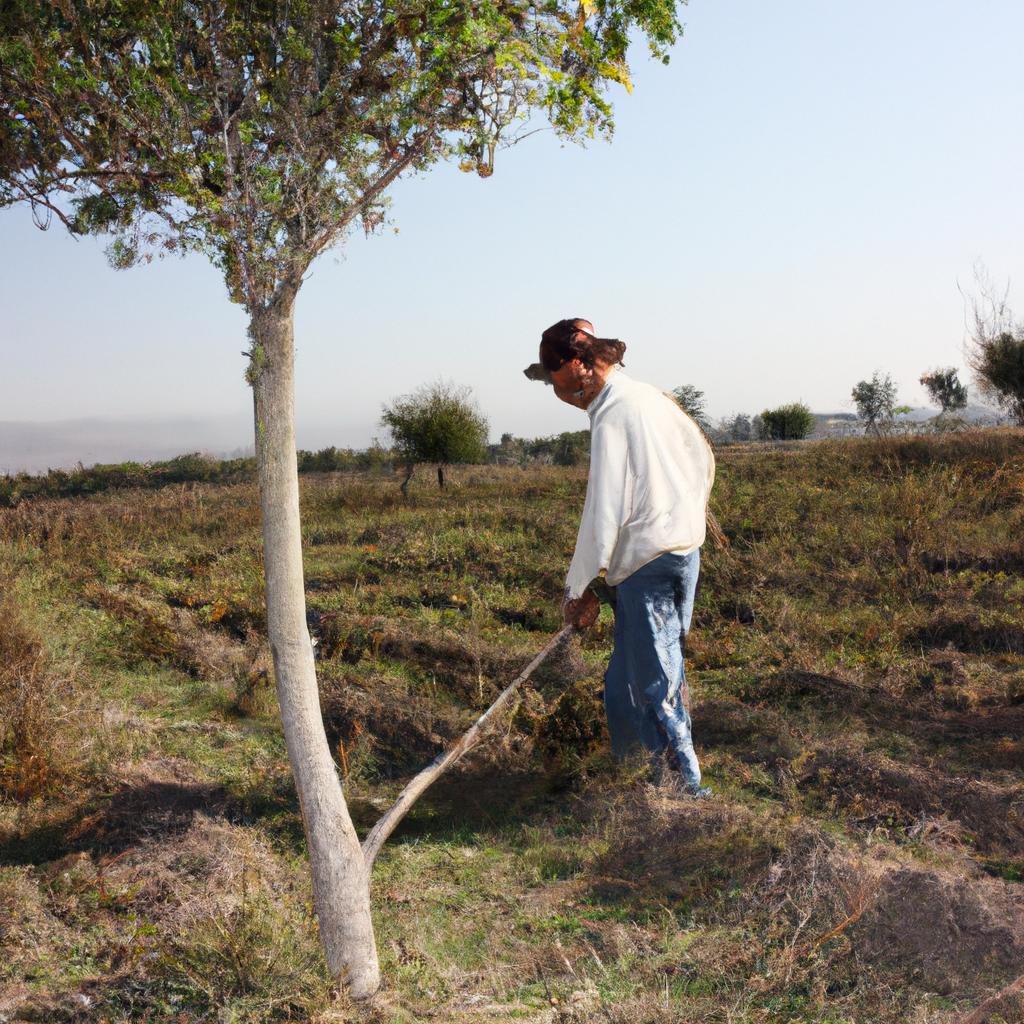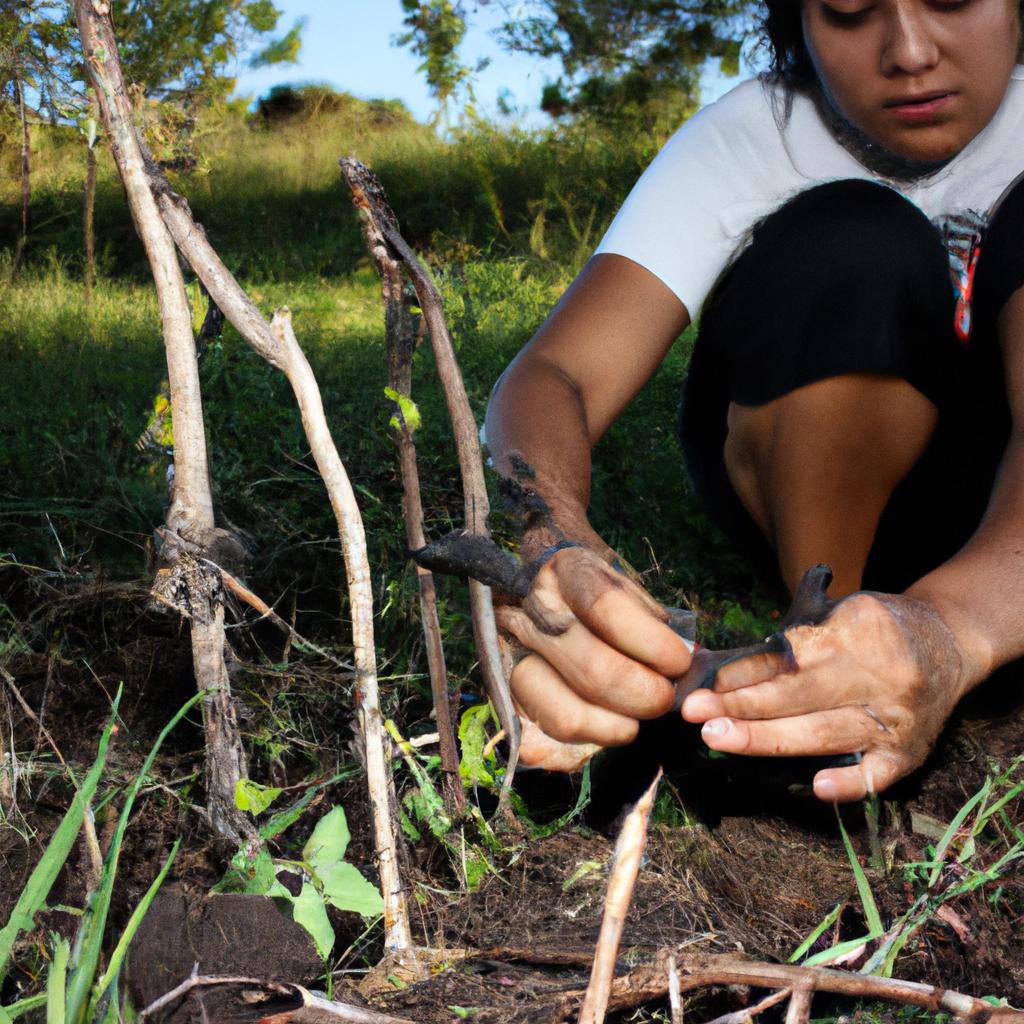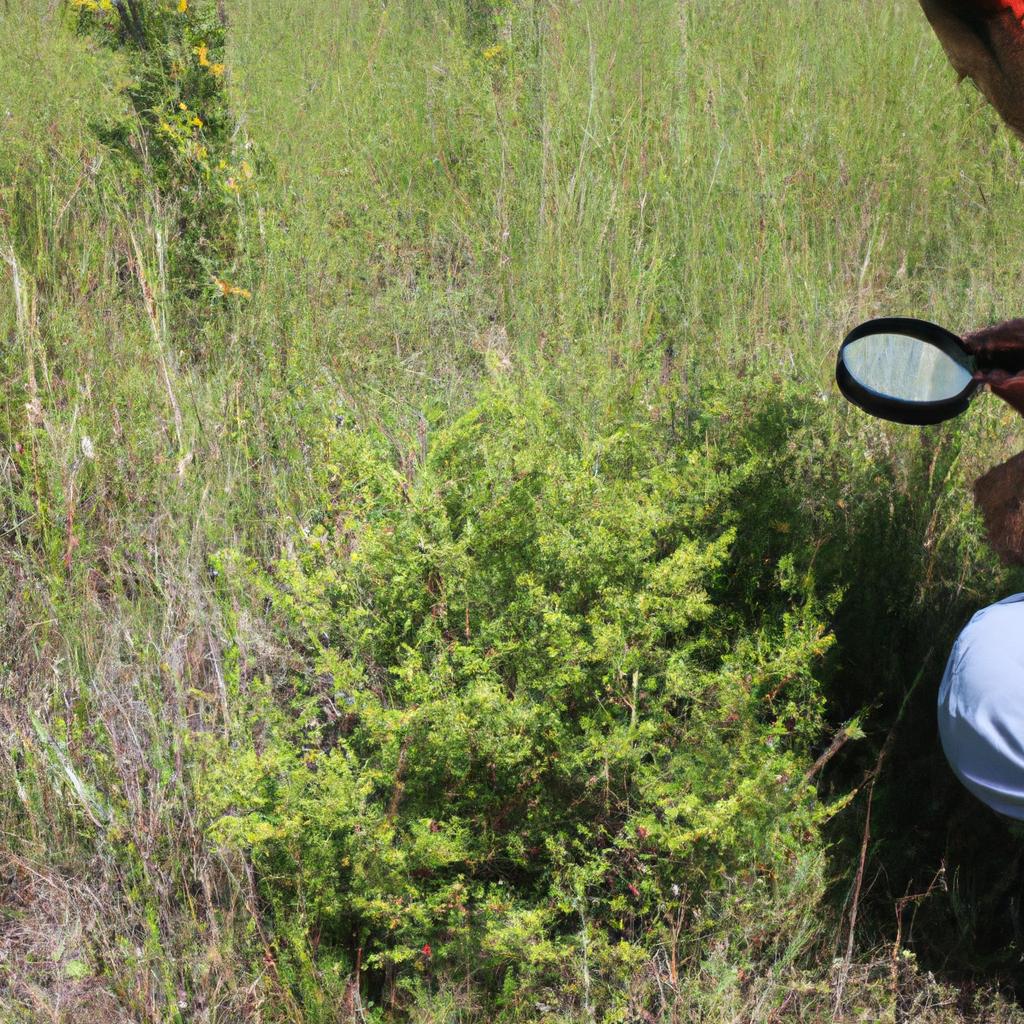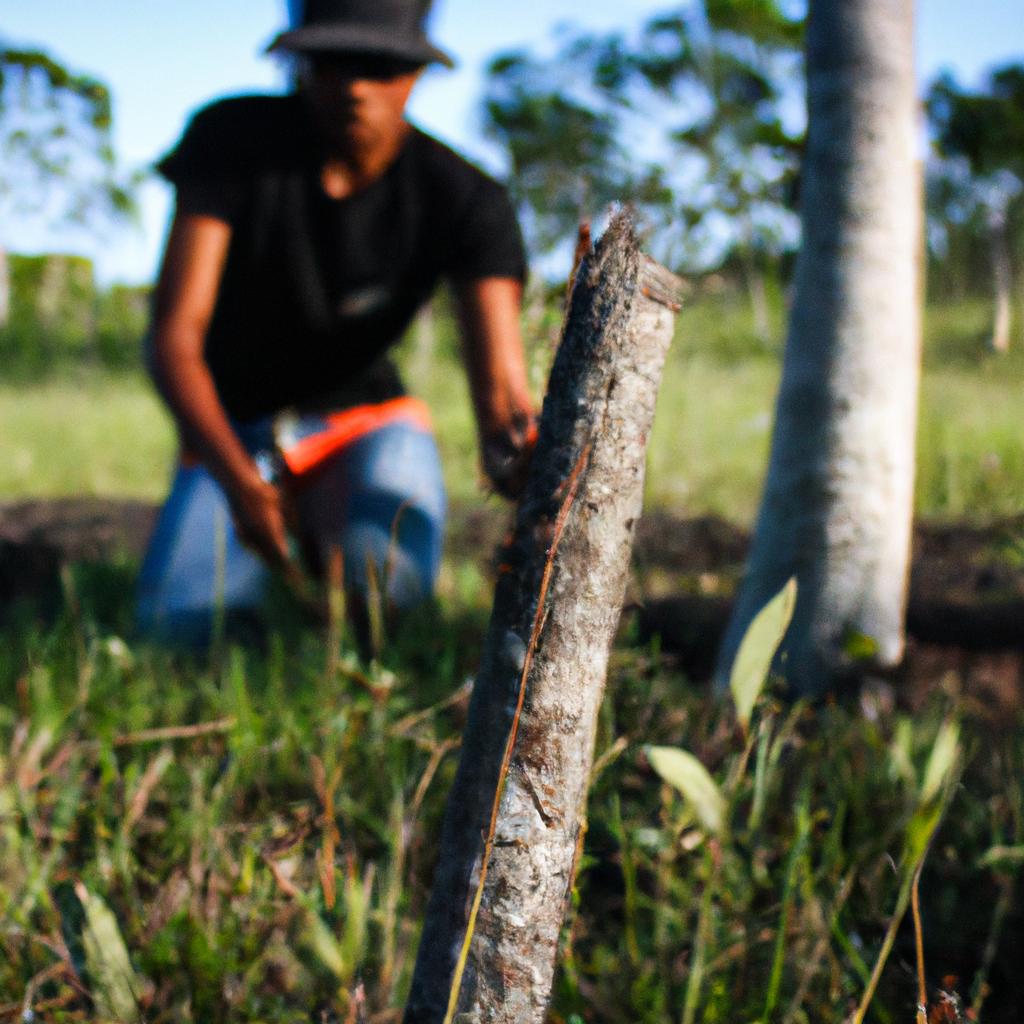Climate resilience in agroforestry is a crucial aspect of enhancing business agriculture and forestry. Agroforestry refers to the practice of integrating trees, crops, and livestock on the same land, offering multiple benefits such as increased productivity, improved soil health, and enhanced biodiversity. In recent years, with the growing impacts of climate change, there has been an increasing need for resilient agricultural systems that can adapt to changing climatic conditions while ensuring sustainable production.
For instance, consider a hypothetical scenario where a farmer in a region prone to droughts decides to integrate agroforestry practices into their farming system. By planting tree species alongside their crops and livestock areas, the farmer creates microclimates that provide shade and improve water retention in the soil during dry spells. This integration not only helps mitigate heat stress on crops but also reduces evaporation rates and minimizes water loss from the farm’s irrigation system. Through this example alone, it becomes evident how climate-resilient agroforestry can play a significant role in sustaining agricultural productivity amidst challenging environmental circumstances.
The importance of climate resilience in agroforestry extends beyond individual farms; it holds potential implications for entire communities and regional economies dependent on agriculture and forestry sectors. As extreme weather events become more frequent due to climate change, the vulnerability of agricultural and forestry systems increases. By adopting climate-resilient agroforestry practices, communities and regional economies can build a more sustainable foundation for their agricultural and forestry sectors.
Climate-resilient agroforestry systems help in several ways. Firstly, they enhance soil health and fertility by increasing organic matter content through tree leaf litter and root systems. This leads to improved water infiltration and nutrient retention, reducing the risk of erosion during heavy rainfall or droughts.
Secondly, the presence of trees in agroforestry systems helps regulate microclimates by providing shade and windbreaks. This reduces heat stress on crops, livestock, and beneficial insects, enabling them to thrive even during periods of extreme heat.
Moreover, the diversity created by mixing different tree species with crops and livestock enhances ecosystem resilience. It creates habitat niches for various organisms, promoting biodiversity that can aid in natural pest control and pollination services.
Furthermore, agroforestry offers economic benefits by diversifying income streams for farmers. The integration of tree products such as fruits, nuts, timber, or medicinal plants alongside traditional crops provides additional revenue sources that are less susceptible to climate variability.
Lastly, the long-term nature of trees in agroforestry systems contributes to carbon sequestration. Trees absorb carbon dioxide from the atmosphere during photosynthesis and store it in their biomass and soils. This helps mitigate greenhouse gas emissions while contributing to climate change adaptation efforts.
In conclusion, climate resilience in agroforestry is crucial for sustaining agricultural productivity amidst a changing climate. By integrating trees into farming systems, we can enhance soil health, regulate microclimates, promote biodiversity, diversify income streams for farmers, and contribute to carbon sequestration. These benefits extend beyond individual farms to entire communities and regional economies dependent on agriculture and forestry sectors.
Importance of Climate Resilience in Agriculture
Importance of Climate Resilience in Agriculture
To illustrate the significance of climate resilience in agriculture, consider a hypothetical case study of a farmer named John. John has been cultivating crops on his farm for several years and relies heavily on the income generated from selling his produce. However, over the past few seasons, he has experienced increasingly unpredictable weather patterns and extreme climatic events such as droughts and floods. These adversities have led to substantial crop losses, financial instability, and an uncertain future for John’s agricultural business.
The example above highlights just one instance where climate resilience becomes crucial in maintaining the stability and viability of agricultural systems. In today’s world, where climate change poses significant challenges to food production and security, it is imperative that farmers adopt strategies to mitigate risks associated with changing environmental conditions.
Climate resilience involves building adaptive capacity within agricultural systems to withstand and recover from climate-related disturbances. It goes beyond mere adaptation by considering long-term sustainability and actively seeking ways to reduce vulnerability to climatic hazards. Here are some key reasons why fostering climate resilience in agriculture is paramount:
- Food Security: As the global population continues to rise, ensuring sufficient food supply becomes ever more critical. Climate-resilient agricultural practices enable farmers to better cope with adverse weather conditions while safeguarding their ability to produce enough food for local communities and broader markets.
- Economic Stability: Farms play a vital role in rural economies worldwide. By enhancing resilience against climatic disruptions, farmers can secure their livelihoods by maintaining consistent yields, reducing financial losses due to crop failure or damage caused by extreme weather events.
- Environmental Sustainability: Adopting climate-resilient practices contributes positively towards ecological balance. Such approaches often involve conservation measures like agroforestry – integrating trees into farming landscapes – which provide multiple benefits such as soil protection, water retention, biodiversity enhancement, carbon sequestration, and improved microclimates.
- Community Resilience: Building climate resilience at the farm level not only benefits individual farmers but also strengthens entire communities. By sharing knowledge and resources, farmers can collectively adapt to changing climates, fostering social cohesion and cooperation.
To further emphasize the importance of climate-resilient agriculture, consider the following table:
| Climate Change Impacts | Consequences for Agriculture |
|---|---|
| Rising temperatures | Reduced crop yields due to heat stress |
| Changing rainfall patterns | Increased water scarcity or flooding, leading to reduced agricultural productivity |
| Extreme weather events (e.g., droughts, storms) | Crop losses, damage to infrastructure and equipment |
| Rise in pests and diseases | Magnified risks of pest outbreaks, increased reliance on pesticides |
As evident from this table, neglecting climate resilience in agriculture exposes farmers and their communities to various detrimental consequences.
In conclusion, given the increasing uncertainty associated with climate change impacts on agricultural systems, prioritizing climate resilience is no longer optional; it is a necessity. The subsequent section will explore how integrating trees into agricultural systems can offer numerous benefits that contribute towards building this much-needed resilience without compromising profitability or environmental sustainability.
Benefits of Integrating Trees in Agricultural Systems
Building on the significance of climate resilience in agriculture, it is crucial to explore the benefits that integrating trees in agricultural systems can bring. By enhancing business agriculture and forestry practices, agroforestry offers a potential solution to mitigate the impacts of climate change. To illustrate this point, let us consider a hypothetical scenario where farmers in a region prone to droughts have implemented agroforestry techniques.
In our hypothetical scenario, farmers decided to integrate trees into their agricultural systems as part of their efforts to enhance climate resilience. This decision yielded several tangible benefits:
-
Increased Soil Health: The presence of trees helps improve soil health through increased nutrient cycling and organic matter accumulation. Their extensive root systems contribute to enhanced water infiltration and retention, reducing erosion risks during heavy rainfall events.
-
Biodiversity Enhancement: Agroforestry promotes biodiversity by providing habitat for various plant and animal species. This diversity strengthens ecological balance and supports natural pollination processes, leading to improved crop yields and long-term sustainability.
-
Enhanced Water Management: The canopy cover provided by trees reduces evaporation rates from the soil surface, thus helping conserve moisture. Additionally, tree roots act as conduits for water absorption, preventing runoff and allowing for better groundwater recharge.
-
Economic Diversification: Incorporating tree crops alongside traditional agricultural commodities diversifies income streams for farmers. Timber production or fruit-bearing trees can provide an additional source of revenue while also contributing to long-term environmental stewardship.
The following table further illustrates these benefits:
| Benefit | Description |
|---|---|
| Increased Soil Health | Nutrient cycling and organic matter accumulation are enhanced with trees present; improved water infiltration and reduced erosion risks due to extensive root systems |
| Biodiversity Enhancement | Habitat creation supports diverse plant and animal species; improves ecological balance resulting in higher crop yields and long-term sustainability |
| Enhanced Water Management | Canopy cover reduces soil surface evaporation rates; tree roots absorb water, preventing runoff and allowing for better groundwater recharge |
| Economic Diversification | Tree crops provide additional income streams; timber production or fruit-bearing trees diversify revenue sources while promoting environmental stewardship |
In conclusion, integrating trees into agricultural systems brings a range of benefits that enhance climate resilience. The hypothetical scenario demonstrates how farmers facing drought conditions can mitigate risks by adopting agroforestry practices. As we move forward, exploring strategies to further enhance climate resilience in agriculture becomes imperative.
Moving ahead with our discussion on enhancing climate resilience in agriculture, let us delve into the various strategies that can be employed to address this pressing issue.
Strategies for Enhancing Climate Resilience in Agriculture
Building on the benefits of integrating trees in agricultural systems, strategies for enhancing climate resilience in agriculture are crucial to ensure long-term sustainability. By implementing innovative practices and techniques, farmers can mitigate the impacts of climate change and safeguard their livelihoods. One such strategy is the adoption of agroforestry, which offers a multifaceted approach to building climate resilience in farming.
Agroforestry combines tree cultivation with traditional crop production or livestock rearing, creating diverse and interconnected ecosystems that enhance overall system productivity and stability. For example, a study conducted in India demonstrated how incorporating fruit-bearing trees into paddy fields significantly improved farmers’ income while reducing water requirements by up to 30%. This integration not only diversified income sources but also reduced vulnerability to droughts through efficient water management.
- Increased biodiversity: Agroforestry promotes habitat diversity, attracting beneficial insects and birds that control pests naturally.
- Enhanced soil health: Trees contribute organic matter through leaf litter decomposition, improving soil structure and nutrient cycling.
- Water conservation: Tree cover reduces evaporation rates from open fields, optimizing water use efficiency during times of limited rainfall.
- Carbon sequestration: The presence of trees aids in capturing carbon dioxide from the atmosphere, mitigating greenhouse gas emissions.
| Strategies | Benefits |
|---|---|
| Diversifying crops | Reduced risk of total crop failure due to extreme weather events |
| Implementing mulching techniques | Improved moisture retention and weed suppression |
| Promoting farmer knowledge exchange networks | Shared experiences provide valuable insights for adapting practices |
| Integrating weather monitoring technologies | Early detection of climatic changes enables timely response |
In conclusion, adopting agroforestry as part of sustainable farming practices can substantially increase climate resilience in agriculture. Through its inherent diversification and ecosystem-based approach, this strategy addresses various challenges posed by climate change while offering multiple benefits to farmers. The next section will delve into the essential role of agroforestry in sustainable farming, highlighting its potential to support ecosystem services and food security.
Understanding the role of agroforestry in sustainable farming allows us to explore how this practice contributes to ecosystem services and ensures food security.
Role of Agroforestry in Sustainable Farming
Enhancing Climate Resilience in Agriculture through Agroforestry
One example of how agroforestry can enhance climate resilience in agriculture is by providing shade for crops during extreme heat events. In regions prone to high temperatures, such as parts of Africa and Asia, agroforestry systems that incorporate trees with wide canopies can help protect crops from direct sunlight and excessive evaporation. This shading effect reduces the risk of crop failure and allows farmers to maintain their productivity even under challenging weather conditions.
Agroforestry offers several strategies for enhancing climate resilience in agriculture:
-
Diversification: By combining different tree species with various crop types, agroforestry systems promote biodiversity on farms. This diversification helps buffer against pests, diseases, and climatic fluctuations, reducing the overall vulnerability of agricultural production.
-
Soil conservation: The presence of trees in agroforestry systems improves soil structure and fertility. Tree roots hold the soil together, preventing erosion caused by heavy rainfall or strong winds. Additionally, fallen leaves contribute organic matter to the soil, enhancing its ability to retain moisture and nutrients.
-
Water management: Agroforestry practices like alley cropping or contour planting can effectively manage water resources on agricultural lands. These techniques involve strategically placing rows of trees alongside crops or creating contours across slopes to reduce water runoff and increase water infiltration into the soil. As a result, these methods improve water availability for both plants and groundwater recharge.
-
Carbon sequestration: Trees play a crucial role in mitigating climate change by absorbing carbon dioxide from the atmosphere through photosynthesis. Agroforestry systems that integrate trees into agricultural landscapes provide an opportunity for carbon sequestration while maintaining productive land use.
| Benefits of Agroforestry Systems |
|---|
| 1 |
| 2 |
| 3 |
| 4 |
By implementing agroforestry practices, farmers can not only increase their resilience to climate change but also reap a range of benefits that contribute to sustainable farming systems. The integration of trees into agricultural landscapes provides economic opportunities and environmental advantages, ensuring the long-term viability of food production.
Transitioning smoothly into the subsequent section on “Economic Opportunities in Climate Resilient Agriculture,” it is evident that agroforestry offers more than just ecological benefits. It presents an avenue for farmers to diversify income sources and enhance their livelihoods while simultaneously adapting to the challenges posed by climate change.
Economic Opportunities in Climate Resilient Agriculture
Transitioning smoothly from the previous section on the role of agroforestry in sustainable farming, we now delve into the economic opportunities that climate-resilient agriculture presents. By adopting agroforestry practices, farmers can not only enhance their environmental sustainability but also improve their business prospects. This section explores how climate resilience in agroforestry contributes to economic growth and diversification.
One compelling example of the economic benefits of climate-resilient agriculture is the case study of a small-scale farmer in a drought-prone region. Traditionally reliant on monoculture crops, this farmer decided to integrate tree species into their farming system as part of an agroforestry approach. The results were remarkable: improved soil fertility due to nitrogen fixation by leguminous trees, reduced water stress for crops through shading provided by trees, diversified income streams from timber and non-timber forest products, and increased overall productivity.
There are several key ways in which climate-resilient agriculture can generate economic opportunities:
-
Diversified income streams: Agroforestry systems allow farmers to cultivate multiple tree species alongside traditional cash crops or livestock production. This diversification provides additional revenue sources through the sale of timber, fruits, nuts, medicinal plants, and other non-timber forest products.
-
Enhanced market access: Climate-resilient agricultural practices contribute to higher-quality produce with improved shelf life and nutritional value. Such products often command premium prices in local and international markets as consumers increasingly prioritize sustainably produced goods.
-
Job creation and rural development: Agroforestry systems require specialized knowledge and skills for planning, implementation, and management. As such, they create employment opportunities for local communities while fostering entrepreneurship and innovation within rural areas.
-
Carbon credits and ecosystem services payments: Climate change mitigation efforts place increasing value on carbon sequestration potential offered by agroforestry systems. Farmers who adopt these practices may benefit financially through the sale of carbon credits or through payments for ecosystem services, such as watershed protection and biodiversity conservation.
- Increased income stability
- Improved livelihoods in rural communities
- Reduced vulnerability to climate-related risks
- Enhanced food security and local self-sufficiency
Additionally, a table showcasing the potential financial benefits of agroforestry systems could be included:
| Economic Benefits of Agroforestry Systems |
|---|
| Diversified income streams |
| Enhanced market access |
| Job creation and rural development |
| Carbon credits and ecosystem services payments |
In conclusion, embracing climate resilience in agroforestry can unlock significant economic prospects for farmers. It offers diversified income streams, enhanced market access, job creation opportunities, and possibilities for earning from carbon credits and ecosystem services. These economic advantages contribute not only to individual farm businesses but also to broader rural development goals. Moving forward, we will explore the policy implications that arise from integrating climate-resilient practices into agroforestry systems without disrupting agricultural productivity.
Policy Implications for Climate Resilience in Agroforestry
Transitioning from the previous section on “Economic Opportunities in Climate Resilient Agriculture,” it is imperative to delve into the policy implications for climate resilience in agroforestry. By formulating effective policies, governments and stakeholders can foster an environment that encourages sustainable agricultural practices while ensuring economic growth. This section explores some key considerations and recommendations for policymakers to enhance climate resilience within agroforestry systems.
One example of a policy measure that promotes climate resilience is the establishment of financial incentives for farmers and landowners to adopt agroforestry practices. These incentives could include subsidies or tax breaks, which would encourage the integration of trees with crops and livestock. By implementing such measures, farmers are more likely to invest in long-term solutions for managing their land sustainably and mitigating climate change impacts.
To further support the adoption of climate-resilient agriculture, policymakers should focus on improving access to technical assistance and knowledge sharing platforms. Providing training programs and workshops on agroforestry techniques equips farmers with the necessary skills to implement sustainable practices effectively. Additionally, creating online repositories or community-driven networks where best practices can be shared fosters innovation and collaboration among practitioners across different regions.
Moreover, policymakers need to prioritize research and development efforts directed towards identifying suitable tree species that thrive under changing climatic conditions. The promotion of diverse tree varieties ensures ecosystem stability by enhancing biodiversity, soil fertility, water retention capacity, and carbon sequestration potential. Investments in scientific research can contribute significantly to expanding our understanding of how specific tree-crop combinations function synergistically in different agro-climatic zones.
In conclusion, policymakers play a crucial role in advancing climate resilience within agroforestry systems through targeted policies and strategies. Financial incentives, improved access to technical expertise, knowledge-sharing platforms, as well as investments in research and development are vital components for fostering sustainable agricultural practices. By adopting these approaches collectively, governments can facilitate the transition towards resilient farming systems that not only mitigate climate change impacts but also support economic growth and environmental stewardship.
Emotional Bullet Point List
- Increased food security for future generations
- Preservation of natural resources and biodiversity
- Enhanced resilience to extreme weather events
- Sustainable livelihoods for rural communities
Emotional Table
| Benefits | Challenges | Opportunities |
|---|---|---|
| Improved soil fertility | Initial investment costs | Market demand for sustainable products |
| Carbon sequestration | Transition period adjustments | Eco-tourism potential |
| Water retention capacity | Knowledge gaps | Climate finance opportunities |
| Diverse income streams | Changing market dynamics | Social co-benefits |
Note: This section provides an overview of the policy implications for climate resilience in agroforestry. Further research and analysis are required to devise tailored policies based on specific regional contexts and socio-economic factors.




